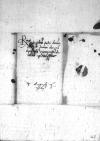List #2579
Stanisław HOZJUSZ (HOSIUS) do Ioannes DANTISCUSCracow (Kraków), 1542-07-24
| odebrano Heilsberg (Lidzbark Warmiński), 1542-08-05 Rękopiśmienne podstawy źródłowe:
Publikacje:
| ||||||
Tekst + aparat krytyczny + komentarzZwykły tekstTekst + komentarzTekst + aparat krytyczny
Reverendissimo in Christo Patri Domino, domino
Reverendissime Domine, domine colendissime
Officiosissimam servitutis meae commendationem.
Nuptias[1] esse prorogatas ad 1543-01-06⌊Epiphaniarum diem1543-01-06⌋, non est clam, procul dubio, Reverendissimam Dominationem Vestram. Itaque laborabit interea, ut ne sit illi proficisci necesse, ac una rationes ostendet, quibus id apud
s(erenissimam) or s(acram)⌈s(erenissimam)s(erenissimam) or s(acram)⌉
Causa
De diplomate regio, ut a consulibus recta fiat ad
s(erenissimam) or s(acram)⌈s(erenissimam)s(erenissimam) or s(acram)⌉
Ad venerabile  AAWO, AB, D. 19, No. 27_2 mentio. Sed quando convaluit iam, Deo sit gratia, rex grandior, subscribet
AAWO, AB, D. 19, No. 27_2 mentio. Sed quando convaluit iam, Deo sit gratia, rex grandior, subscribet
Germanicus exercitus iam est
Quae inter
Scarparia terrae motu quassata concidit neque domus in ea integra ulla remansit. Imaginem Divae Virginis locutam ferunt, ad quam ingens fit hominum concursus.
Deum precor, ut Reverendissimam dominationem Vestram diu servet incolumem. Cuius me gratiae commendo.
Eiusdem Reverendissimae Dominationis Vestrae servitor deditissimus hidden by binding⌈[imus]imus hidden by binding⌉


